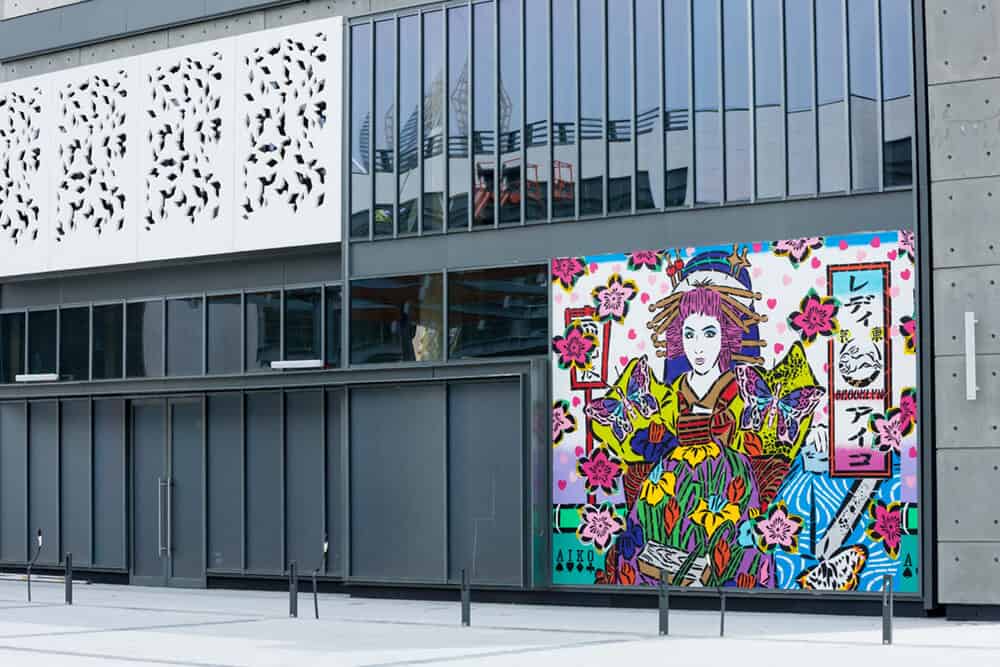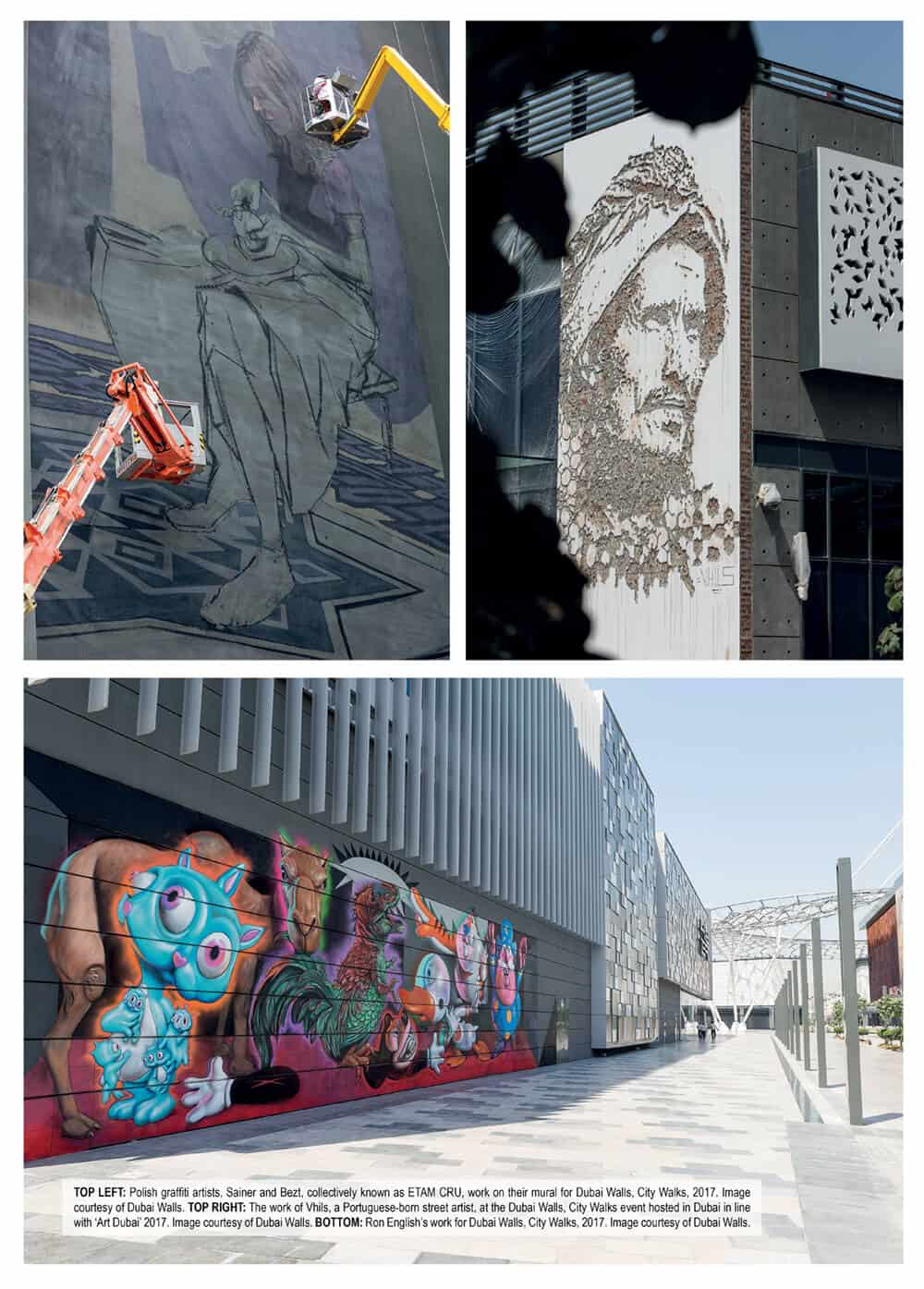There is art in urban life. Not just in physical spaces, but in the patterns created as people move, connect, and go about their lives. This is the active urban life that inspired Dubai Walls, a ground-breaking street art initiative by Meraas.
Ellen Agnew: You have said that the public art scene in Dubai is quite slight, and has a very different culture to that of your birth country – Japan. Could you please tell us the differences between these two principles of public art, considering that modern Dubai is fairly young?
AIKO: I was born and raised in Tokyo, Japan. Even though the city was completely destroyed during World War II, and has been quite westernised, a very unique culture and tradition remains.
I wasn’t surprised by the high skylines in Dubai because Tokyo is also a massive concrete jungle – but I did pick up on the many other differences and similarities between these two cities.
Dubai is a very young city in such a tough climate. Locals told me that electricity arrived in Dubai about 60 years ago, which allowed for its birth in the desert. Apparently, a local scene and culture didn’t exist before electricity arrived there, or rather, Dubai created their own ‘culture’ then. For example, my host introduced me to a mixture of other middle eastern countries’ cuisine as ‘local’ food. People’s lives are supported by an all imported source and supply – Dubai doesn’t really produce anything. I suppose I discovered that Dubai is a big showcase of our planet and the future.
My artwork for Dubai Walls is located in a new mall, known as City Walks. It’s the first outdoor mall in Dubai, and the artwork is viewable from the street. City Walks is also designed to imitate the small streets of New York or London, where one can walk through these streets, shopping and dining.
My mural for Dubai Walls is about excitement and the entertainment of others, rather than a socio-political statement. I was commissioned to paint a Japanese Geisha walking under a cherry tree in Dubai.
Do you think this is because Dubai has only recently emerged as a global city, and arguably has no crisis of history to inspire public artists – most of whom are usually regarded as tackling social issues of society’s matters?
Dubai might be a young city, but there are already many issues to speak and create art about. For instance, I saw beautiful and amazing areas of Dubai, but I also saw thousands of Indian and Pakistani people getting on the same dusty buses and working on very expensive constructions every day. I assume that they aren’t paid very well. That’s already inspired some of the public artists, I think.
I started street art because I was able to access tools and materials – and there are amazing streets to run around in New York.
I’m more concerned that the lack of materials and tough environment discourages artists and artistic people in Dubai, rather than the social concerns.
Local art stores sell spray paint for double price – we had to import all spray paints from Europe. We also had to deal with the most painful heat strokes and sunburn from working outdoor during the day – this was definitely the most challenging part of Dubai Walls. I took a walk around the Old Town neighbourhood to see if any locals had done some public work, but I can imagine that it’s a struggle for them – having to import expensive spray paint – they won’t easily be able to make art in public space. I experienced the same issues while traveling and working in other countries such as South Africa, India and China – they don’t have decent spray paints, and the weather is quite tough.
 Lady Aiko stands in front of the mural she painted for Dubai Walls, City Walks, 2017. Image courtesy of Dubai Walls.
Lady Aiko stands in front of the mural she painted for Dubai Walls, City Walks, 2017. Image courtesy of Dubai Walls.
Your artwork makes reference to femininity, sexuality and the beauty of human life – can you please tell us more about how you visually interpret these topics, and why they’re best communicated through public art?
Graffiti and the street art scene is predominantly male, just as it is with most other industries – and society in general. I think it’s great that a girl paints images of beautiful girls and feminine motives on the streets – I thinks it’s like sending positive female energy to everyone in a public space. Usually my art is about love stories, beautiful colours and images, the hope it gives people, the smiles and inspiration – it feels good to be there and be creative. I love working in public spaces because I can give it to everyone.
I spent a few weeks in Dubai producing the artwork for City Walks. During this time, I saw many women completely covered in black cloth – their burkas. They passed by my wall while I was wearing shorts and a t-shirt, and painting an image of a very dressed-up Japanese lady – a very colourful kimono, with lots of hair and make-up. I can imagine that it must have been quite a shock to them! But I hope that they enjoy seeing and experiencing this aspect of Japan.
Dubai might be a young city, but there are already many issues to speak and create art about
You have explored a combination of contemporary American art movements, such as Pop Art and Graffiti, with traditional Japanese aesthetics. How do these opposing ‘art cultures’ complement each other, and which areas of art movements would you like to explore next – assuming that your style might transform?
I moved to New York in the mid-nineties, and as a young Japanese artist I was fascinated by American art movements. I was especially influenced by Pop Art – artists such as Warhol, Basquiat, and Haring, and also the New York subway art movements. I started to make art with local friends in the streets of downtown New York, and that opened the door to play with international street art and graffiti movements. I have been continuously travelling and working on projects since then and haven’t stopped yet.
Travelling is the biggest part of my life – my work has allowed me to visit and work in many different worlds. Since 2012, I have travelled to and around South Africa almost ten times – painting and spending lots of time with local people. African nature, tribal art and traditional culture – and troubled contemporary societal issues – are inspirational and make me question many things.
I recently went to Tibet, and it was also very fascinating. Temple art is definitely my next area of study.
Again, as a young girl I was very curious about the world outside of Japan. I then spent enough time overseas to come back to Japan, and appreciate the beauty and uniqueness of my roots. My upcoming exhibition is at Tokaido Hiroshige Museum in Shizuoka Japan – Hiroshige references the Japanese Ukiyoe master from the 19th century who travelled all over old Japan and create beautiful art. In this exhibition, I am going to introduce my many past projects and travelling to a Japanese audience, also exhibiting wood block prints and a collaboration with local traditional Ukiyoe crafts man.
How do you think the Dubai Walls initiative fitted in with the overarching theme of ‘Trade’ at Art Dubai 2017?
I think a theme of ‘Trade’ makes perfect sense based on the general nature of the city being so business orientated and international. Creating dialogue and having visiting artists bring new and fresh ideas to the residents is a good example. Sharing with other artists present as well as learning about the local cultures is a lot stronger than the typical understanding of trade where two sides are simply exchanging. The level of trade is not limited to a simple transaction of giving one thing for another in return. I think Dubai Walls has gone far beyond.
Ellen Agnew is a staff writer at ART AFRICA magazine.

Read our editorial of for ARAFRASIA, ART AFRICA issue 08, here. We also did coverage on Global Art Forum in Dubai.



